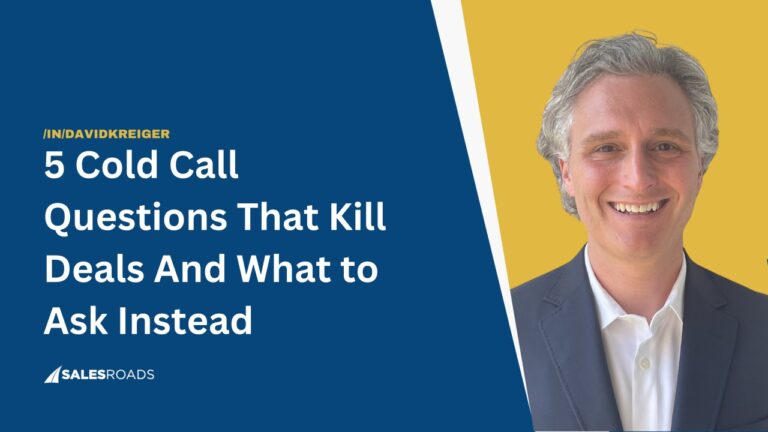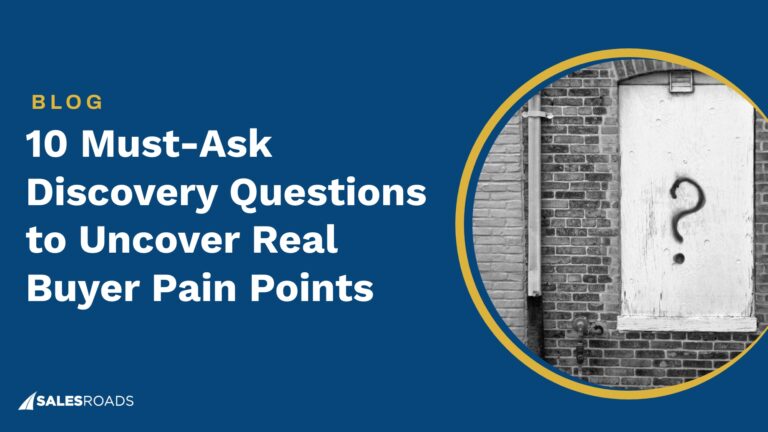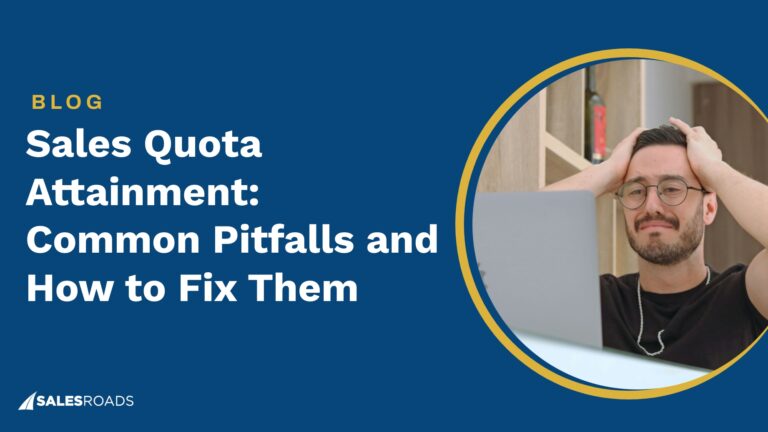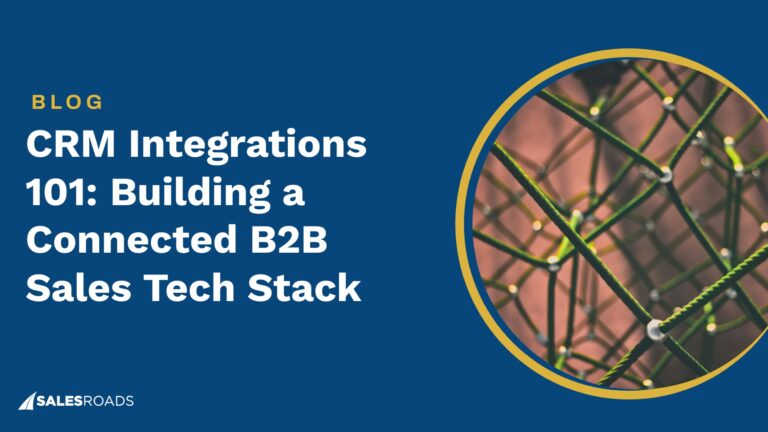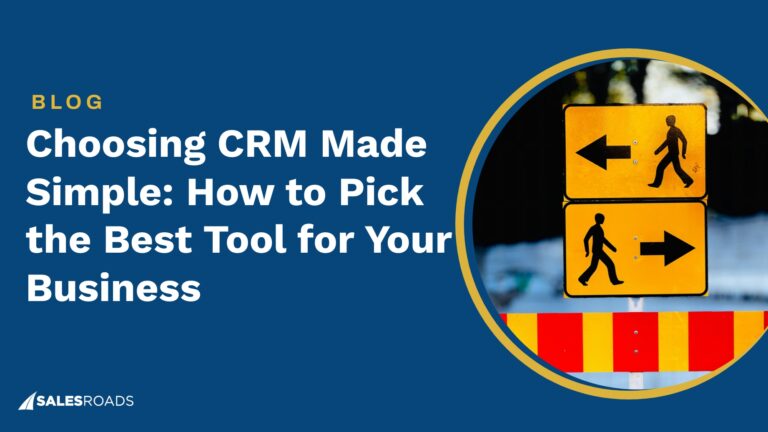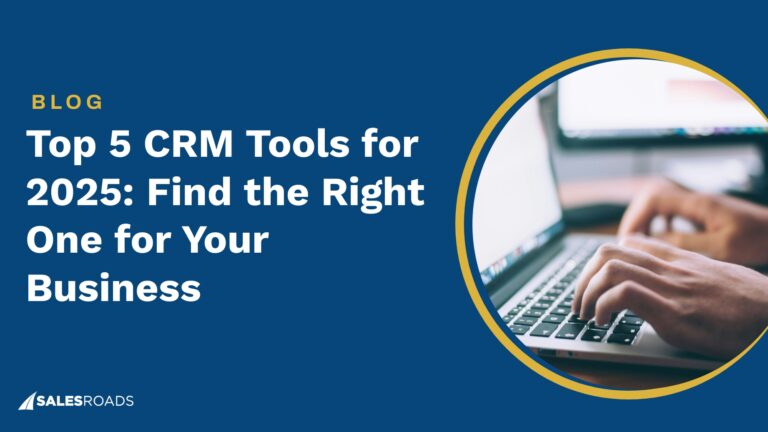Sell Like A Leader – Episode 7
In this episode, we dive into:
– Experimenting in sales: how over-reliance on technology and rigid sales processes can reduce effectiveness, the systemic issue with sales that doesn’t create a culture of experimentation, how sales leaders can cultivate a culture of creativity and experimentation within their teams, narrowing down your ICP through experimentation, and the two questions managers should be able to get answers from their sellers regarding every single opportunity in their pipeline.
– Experiment #1: the old-school way is new again and the thing you should invest in if you have a six-figure ACV.
– Experiment #2: the one where you can not pitch a product.
Note: Part II of this interview will be released soon as Episode #8.
About Andy Paul
In this episode (Part I of II), David Kreiger chats with Andy Paul, a renowned sales expert known for his innovative B2B selling strategies. With a career spanning decades, Andy is a trusted advisor to CEOs, entrepreneurs, and sales leaders around the world. He is also the host of The Win Rate Podcast and the author of three best-selling books, including Sell Without Selling Out.
Podcast Key Takeaways
- Andy Paul emphasizes that sales environments are constantly changing, requiring sellers to be adaptable. He highlights the importance of continuous experimentation with new strategies, tactics, and techniques to understand what works best for both the salesperson and the customer.
- Andy voices concerns that the sales industry has shifted towards conformity, driven by rigid processes rather than flexible frameworks. He advocates for a culture that encourages creative problem-solving and independent thinking, which he believes leads to better outcomes for both sellers and buyers.
- Andy shares two sales experiments he advises sales leaders to implement in their sales strategies.
Connects
Connect with Andy Paul: https://www.linkedin.com/in/realandypaul/
Connect with David Kreiger: https://www.linkedin.com/in/davidkreiger
Subscribe to the podcast and follow us on the LinkedIn page so you don’t miss any episodes!
Transcript
David: Experiment, experiment, experiment. That is a direct quote from today's guest. So, find out in this episode what are the three experiments that sales leaders should be running this year. This is the Sell Like a Leader podcast for revenue leaders who are on a mission to cultivate a high-performing sales team within their organization.
I'm your host, David Kreiger, founder of SalesRoads, America's most trusted sales outsourcing and sales leader. And today I am so excited to have our guest, Andy Paul. I'm sure most of you guys know Andy, but he is a renowned sales expert and author known for amazing B2B selling strategies.
He's got a career spanning decades and has been a trusted advisor to CEOs, entrepreneurs, and business leaders, and sales leaders around the world. Just to give you a sense, Andy has over 190,000 professionals following him [00:01:00] on LinkedIn.
And his work has been instrumental in shaping the sales strategies of numerous companies. He is the host of the WinRate podcast and author of three best-selling books, including Sell Without Selling Out, and he's working on what will be his fourth best-selling book, which will come out later this year. Andy, so excited to have you. Thanks so much for being on the podcast.
Andy: David, thank you for having me. Always, yeah, I always enjoy talking with you, so I'm glad we, we sort of discovered each other somehow in the last couple of years, so we seem to be talking quite a bit,
which I enjoy.
David: I was one of those 190,000 followers, Andy. So, you know, I stalked you a little bit and got, got to have a chance to build a relationship and just always enjoyed our conversations.
Andy: Likewise, David, you're a guest on my original podcast as well as the most recent one, so…
David: Yeah, it's always fun… Great. You have great insights, cutting insights. You don't like the BS, which is, which is always great. And you cut through the clutter here, which is what we're going to do today. And [00:02:00] so I actually noticed a recent LinkedIn post, uh, that you had put out there about the need for experimentation.
And in the post, you know, you talked about how you have to constantly experiment with new strategies, tactics, techniques to just figure out what works best for you as a salesperson. And so, you know, I would love to just start, we're going to dive into that in some detail, but I'd love to get a sense from you as to just why you feel like experimentation is so important in sales.
Andy: Hmm. Well, cause a couple of reasons. One is, you know, the environment we sell to is always changing. So we need to be able to be adaptable and respond to that. Uh, you know, as Darwin said, it's not the fittest that survive. It's the most adaptable who survive.
So you need to be ready to be adaptable. And in addition to which, you know, we're never finished products, right? As humans, as sellers, we're constantly evolving, hopefully, um, in response to the things that are going on [00:03:00] around us. And as you said, I've been doing this for unspecified number of decades. Every day, I'm still trying to learn something and something I can apply to selling.
So yeah, you never want to stop that. So the experimentations should be part of what you're trying to do each and every time you're interacting with a prospect.
David: Yeah. And I think two things, just to call out on that one, which I wasn't even thinking about. You know, as salespeople, right? We do want to learn every single day. Otherwise, potentially, our job can get stale. And so it's a way for us to continue learning, to be curious, to see what's working, and it actually makes our job more fun instead of doing the same thing every single day.
Andy: Should be a creative process, right? I mean, that's, to me, one of the things that's kept me in sales all this time. In addition to just, yeah, you can say, well, gosh, it's helping buyers and, you know, solving problems and so on.
But in fact, those all sort of come back to being creative. And the experimentation part of that is, how can I get better?
And I guess I've, you know, I'm sort of a little bit [00:04:00] of a skeptic too, and I think this is maybe increasingly so over the last couple decades is, you know, sales has become more about conformity. Right? When I started, I'm sure we had processes, but we really had frameworks.
We were given, we were trained in frameworks and given freedom within the framework to experiment, you know, try to become the best version of ourselves because yeah, not everybody was going to succeed the same way, but you've seen sort of with the advent of more and more technology in sales and a generation of managers that are more comfortable sort of saying, Hey, this is the recipe.
This is the playbook. This is the way we should do it. You lose some of that creativity. And yeah, I think that's hugely important. If you're always going to go into the same meeting asking the same questions, it gets kind of boring and stale to the point you made earlier.
David: Yeah. And I think that it is interesting how technology, and we were talking about this a little bit in the pre-show, uh, can force us into conformity. I mean, with these amazing tools, right? With cadences, with you know, Salesloft and Outreach, [00:05:00] all of a sudden, everybody is supposed to follow that exact cadence, and we are all looking at, you know, Salesloft’s numbers and metrics as to what is the best cadence.
And then everybody starts following that and lo and behold, and this goes to the other point I think you brought up, which I think is really interesting is that when everybody goes in the same direction and starts doing the same thing, especially in sales, especially in prospecting, when there's sort of an exponential aspect of, you know, more and more people are doing it.
And so therefore more and more buyers are seeing it. That the environment changes, and all of a sudden, something that didn’t work or was working well before doesn’t work now. And so if we are all lemmings and following the same process over and over again, not only does it make things boring and stale, but it actually makes things less effective.
Andy: Yeah. Well, I think you can also make the argument that we really haven’t been that effective, right? That, you know, 20 years ago, sort of in the advent of SDRs and, you know, specialized sales roles, I guarantee no one [00:06:00] went to the buyers and said, look, how would you like it if we sold to you this way, right?
We’re going to have our least experienced person pick up the phone and call you and try to take some of your time. And then we’re going to hand you off if you agree to somebody else. And then, and it’s like, no, buyers would have said absolutely not. Right. They didn’t ask to be sold to this way.
And you can really look at the data and say, well, has it really been effective? Has it been any more? I mean, you can make the case arguably it’s been less effective than what preceded it. I mean, you look at, uh, overall win rates and quota attainment, and perhaps most significant of all, just the buyer dissatisfaction with the interaction with sellers.
I mean, let’s not kid ourselves, you know, buyers never want to talk to sellers, but they’ve become much more certain about the fact they don’t want to talk to them in the last 10, 15 years. And I think that’s really a result of how we’ve been trying to sell to them.
David: Yeah, and I think a lack of imagination because I think, and this is going to go into the experiments and why I think, you know, [00:07:00] both you and I, you know, think experimentation can be so critical in the sales process is that we see that things are working.
You know, Aaron Ross stumbled upon something that was working for Salesforce, and nobody else was really doing it in the same way.
And maybe you can argue against even that premise, but we can say that it has gotten more difficult over time as more and more people have structured their sales teams that way. And then to compound it. They’re running the same plays.
And so it just makes things worse and worse and worse because, and I think you're saying that, which is interesting and we can be interesting, just at least touch on it, but that it’s a systemic issue with sales that doesn’t allow for this type of experimentation or it doesn’t create a culture of experimentation and we all start doing the same thing, which is not good for the buyer, is not good for the seller, and it’s just not good overall.
Andy: The whole premise of predictable revenue was we're going to take an example of one, which was Salesforce, which was the right product at the right time.
And you can make the argument [00:08:00] that you could have sold it a number of other ways, and you would have had to experience the exact same success. But we're going to take that as a playbook and apply that broadly to all SaaS companies.
And you can just look at the data and say, well, you know, it didn't really work. It doesn't mean that, you know, there haven't been examples of companies that have succeeded. But my point would be is they were the right product at the right time, whether it's, you know, Outreach or Salesloft or Gong or whatever. It wasn't the sales model, it was the product.
And outside of that, you would say, well, geez, if this sales model really was great, maybe we would have seen a higher success rate of venture-funded companies, right? Because this is the way buyers want to buy, but it didn't move the needle on that at all.
And what we've seen is this environment where people conflate high valuations with success of the sales model. And as we know, in times of easy money, those two aren't really connected. And so, yeah, I think you can look at the data and say, hey, during this, this era of quote, predictable revenue—and Aaron and I've debated this on my [00:09:00] podcast—you can make the argument it's, it hasn't really worked, right?
Better than what any alternative could have been. It's just the one we had at the time, but it was all premised on this idea of we're going to do things the exact same way, time after time after time. And this is the process.
And I've made the argument many times is that, yeah, we've created an industry, let's say on software as a service, where win rates are, if they're in the mid-20 percent, that's pretty good for a lot of SaaS companies.
And that's success, you know, in a business-to-business environment, you're only winning one of every four or one of every five of your most qualified opportunities. It's not success. And in my book, I don't think it's in the universe, but that's a success from a sales perspective.
Again, not to be fooled by valuations as you see on LinkedIn. Somebody writes, well, I was at company XYZ when I ran sales, and we went from, you know, 7 million to 7 billion valuation. And it's like, dude, seriously, let's not get carried away. That wasn't sales success.
David: I [00:10:00] think this is an interesting place to jump off and there's obviously so many different directions we can go, but I'm going to go with the experimentation direction on this because I think it's fundamental.
And that actually took us to where we're talking about today.
So if you are a SaaS founder or SaaS leader, or just a sales leader in general, right? And you're seeing your win rates in 20%, I think a lot of CROs would be ecstatic. So maybe they're 10%, maybe they're low, whatever it might be. So they're seeing something that they feel is not working. They're not hitting their numbers.
You know, what's some of the advice that you would give, first of all, just at a high level on experimentation? Then, if you want to get into maybe, you know, a handful of experiments that you think are important for sales leaders to think about and that you've either seen success in or you think would be interesting to discuss, I think it would be great to hear that from you.
Andy: Well, I mean, the argument for experimentation is, as I just said, what you're doing isn't working, right? I mean, what we're seeing in SaaS is sort of this—even this move away from emphasis on [00:11:00] sales to purely on revenue, right?
So, hey, I don't want to get too focused on what the sales team is doing because we're really all about, you know, renewal and upsell and so on, which is, you know, one issue.
But I think from a sales side is it's just, I don't know any other way to express it on there. It's just not working, right? If you had a 20 percent win rate, what you're doing is you're saying is, you know, we're making really bad choices about where we're choosing to invest our time as an organization because we're going to invest it in people that really are never going to buy from us or have a very low probability of buying from us.
And the way the model has evolved is, to the point you made before, we've gotten really pretty good with marketing automation and so on—various sales tools to generate, you know, things at the top of the funnel.
Don't even know the leads, we'll call them, right? At the top of the funnel.
And what someone discovered fairly early on in this is, well, as long as they're that, you know, we're selling to sort of this infinite TAM where we can generate opportunity at the top of the funnel, we really don't need to be that good as sellers, right? Because we're going to get a certain yield. [00:12:00]
It's almost like—and I like to make the argument that at 20%, I could probably run an experiment and say, instead of selling to them at all, when you got a sales-qualified lead, just send them a proposal. Demo. Don’t do anything—just send them a proposal.
I guarantee you're going to win anywhere from 10 to 20 percent of your opportunities that way. Nothing—probably a yield almost as much as the way you're yielding it now at a 20 percent win rate. Again, a little bit of hyperbole there, but you get the point, right?
Much better than doing nothing. If that's the case, well, let's do nothing then. Right?
Yeah, I worked for a boss early on in my career who sort of took that approach. He did it as purely a qualification exercise, but he said, when we get a lead, we have one conversation. We send everybody a quote, which we did. And boy, yeah, we weeded out the people who weren't serious pretty quickly.
My thought at that time was, yeah, I'll bet you if there's some I didn't follow up with, I would probably win some number or some percentage of those. But I think it's largely true. With, yeah, companies, low win rates—doing nothing is not much different than what you're investing time in today.
So yeah, if you're at that, you have to experiment, [00:13:00] right? I mean, it has to be—why would you think that it's good for anybody to be at that type of win rate?
I mean, even if you're a seller that’s making quota and you're only winning at a, you know, let's say a 30 percent win rate—yeah. I mean, when I was growing sales teams in my early part of my career, we moved people out that only were at 35 percent win rates. You know, the minimum standard I required—and still believe sellers should have—is you're going to win more than you lose.
So that's it. You're going to win more than you lose. And so, how do you get to that point? Well, you have to do a better job of choosing who it is you're going to sell to. And right now, I think too many sellers just, yeah, I get handed a lead. They feel like, compelled, like they have to sell to them. It’s like, no, no—disqualify those that aren’t a fit, right?
You have to make a choice. You've got a limited amount of time as a seller—limited time, attention, you know, bandwidth in there in addition to time—where are you going to invest it?
And yeah, I'll work with companies, and I'll go through a pipeline review, and I'll go through a pipeline, and I'll say, so why is this opportunity in the pipeline to a seller?
David: Too many.
Andy: Uh, [00:14:00] well, yeah, they seem to have an interest. So my next question is, well, why are we going to win?
“Well, I don't know. I haven’t talked to them enough.”
I said, no, no, no. You should know, right? If they're going to come into your pipeline, you have to have a pretty good idea why we're going to win. Doesn’t mean we will, but you should know why we're going to win before they come into the pipeline.
Why are they there? And that level of rigor just doesn't take place, right? I talk about Sell Without Selling Out. I said, here's the acid test. You know, as a manager, you should be able to go through every opportunity in somebody’s pipeline.
And you should get the answer to these two questions from the seller, which is:
What does the buyer need from us today? The prospect, in order to make progress toward making the decision. What are they waiting for from us today? What are they expecting from us? And in exchange for that, what's going to be the next step?
And if a seller can't answer those questions about something that's in their pipeline, they're just not engaged at the right level, right? They haven't asked the right questions. That's not an opportunity. Shouldn't be in the pipeline.
I saw a post on LinkedIn this week from Michael Hoffman, who's the CEO of this company called Pathsite that [00:15:00] does win-loss analysis. And he said, you know, we've just done 2000 interviews—B2B SaaS interviews and win-loss analysis interviews.
Excuse me, I forget the exact figure—I think it's like 90 percent of the cases, you know, when we asked the vendor to tell us, you know, asked the customer, excuse me, to tell us, “Well, so this vendor—can you explain to us what they do?” The prospect said, “No. I couldn’t.”
And my response to that was, well, so you weren’t doing win-loss analysis because they were never in the competition to begin with. If you're selling to people who fundamentally don't understand what you do, you were never in the game to begin with.
Why are they in your pipeline?
And this gets to the issue—you know, they're choosing to spend time with people that they just don't have the possibility of the high probability of winning, and that needs to change.
David: And so to increase win rates, it sounds like the two biggest drivers are first figuring out who is your ICP and really defining that pretty clearly, and knowing who you should be having those conversations with. And then [00:16:00] two, related to that, qualifying them, right?
Uh, in the right way and getting them out so you can focus your time on them as efficiently as possible. Once you've done that, are there other important things or, going back to the question of experimentation, are there other things you can do to experiment with your process of bringing people through the pipeline or even, you know, experiments around who your ICP is, you know, where does experimentation sit when you're trying to increase your win rates at your organization?
Andy: Right. Well you, so you use the word efficient. I, it's—the word is really effective because the minimum goal for every interaction with a buyer that's in your pipeline should be that as a result of this interaction, they're closer to making the decision afterwards than they were beforehand.
Otherwise, what was the point of doing it, right? What's the point of having the call? What's the point of sending the email? What's the point of having the meeting? If at the end of it, they're not closer to making their decision than they were beforehand. So that's [00:17:00] effectiveness, right? And that's what the buyer considers value.
And I wrote about this in Sell Without Selling. Value to the buyer in their buying process is progress. Have you helped me make progress toward completing this job I have, which is to make a decision? And so you have to experiment to say, okay, what am I doing or not doing that creates this desired impact, which is progress.
And that then becomes something you can repeat. I mean, every situation is a little bit unique, but you have this basis of saying, look, when I talk to customers, we go through this, or I give this insight or I share this, ask this question, whatever it is, it has this desired impact of helping them make progress.
So you constantly experiment with that. I mean, the thing that, you know, another reason why experimentation is so key in this is that yes, you're in an ICP and you want to narrow that down as tightly as possible, which you can help yourself by doing by increasing, you know, as you become more effective and improve your win rate, your ICPs become more and more targeted, [00:18:00] because you're going to get the feedback of who's buying, right, based on what we're doing.
But even within that, you know, every customer is—look, the same. They can feel the same to you. They have a lot of the same criteria, characteristics. But the humans are different. You're talking to humans.
And so even within this very narrow band, you need to be able to constantly sort of experiment and improvise a little bit in the moment because you and I can be, you know, CEOs of companies that do the—from the outside—do exactly the same thing.
I'm going to look at my business a little differently than you. Right? Maybe it's my culture. Maybe I think the way we do business, the way we approach our customers, maybe we think about our customers just differently than you do.
Well, you know, we do really do our sellers a big disservice. We train them and say, hey, you're going to talk to this persona, this ICP, and you ask these questions, you're going to get this answer. Not necessarily, right? And so you want to be alive to that possibility, the fact that it is going to be a little bit [00:19:00] different.
And you want to really understand their unique perspective on their situation. And that requires, you know, different types of questions, perhaps, from one to the other, even though the companies look very similar.
And that should really be the goal of a seller, is not, "Hey, how can I confirm that this buyer is just like the next buyer?" It's "How can I confirm this buyer's different and how they're different than the next one?"
Because if I identify and really understand those differences, that's going to be my door opening to winning the deal.
David: At SalesRoads, uh, we're in sales, and, you know, I think you probably come across this a lot in the research you do for your books. This is a social science—very much a social science, right? Where you can't run a perfect lab.
Can you walk us through three experiments that you think sales leaders should incentivize their salespeople [00:20:00] to run? And if you can, you know, talk a little bit about the process and the steps of the sales leader in facilitating that experimentation.
Andy: Well, one is a little more global, but it's something that I think it's new to a lot of sales leaders—is you need to experiment with having your sellers travel to meet accounts. So we had talked about just, you know, what a tough environment it is for, you know, top-of-funnel activity—outbound in particular—because we've used all these tools in ways we probably shouldn't have, to bombard users.
But I think that if you're an AE and you—yeah, let's just say you're selling to mid-size enterprise accounts, you've been working on enterprise and you've got a target account list, which you should have. You shouldn't just have open book, right? You should have 60 accounts or—you know, that's what my friend Anthony Iannarino talks about.
You should have 60 accounts. Let's take that number of 60 accounts. Go spend time with those accounts. There's nothing better in terms of [00:21:00] trying to develop a piece of business at an account. And there's no better way to get signals or intent data than from meeting with people.
And it's—yeah, it may sound old school, but it's so old, it's new again. If you're selling anything with a decent ACV, visit people, get to know your accounts.
The people you want to talk to—the decision-makers—there's a higher likelihood than not that they are back in the office. And go meet them.
Go get to know them. It will be a differentiator for you. It'll work against you if you don't, quite honestly, at this point, because more and more companies are starting to do this again.
And yeah, you know, CFOs may push back because, you know, suddenly we start using expenses. But again, if you have a six-figure ACV, invest in a plane ticket. Or, you know, another alternative I suggested too as an experiment—and I was talking to a client and they sell a product that, you know, big [00:22:00] companies, mid-size big companies use—and they were located in one of the major cities in the U.S.
And I said, well, try something different this year. Only sell to accounts you can drive to. And they're like, well, no, we were virtually selling. I said, yeah, you can sell anywhere you want to—there's more than enough TAM in your major metropolitan area of millions of people and lots of big companies’ headquarters. Only sell this year—you're only going to sell to companies you can go drive to and meet in person.
David: I think that that's fascinating. And I think that we all forget because we're so virtual now and we've been conditioned—it's been like four years, right?—that we've been doing this, that we're selling on Zoom, that this is now the way to sell. But I think to your point, it does two different things. One, it's very hard to get to know your buyer in a 60 or even 30-minute discovery call, and then this set of processes, you know, of meetings after that.
Versus sitting across the table from them, maybe even—dare I say it—having lunch with them afterwards. That you, you know, it's a way that you can really learn about [00:23:00] them.
And then secondly—and I know you said you have to justify it to the CFO—we spend so much money on technology and tools and things like that. But this is a way to differentiate yourself from the competition. You actually getting on a plane while they're just doing Zooms, and your win rates, to your point, will go up tremendously.
Andy: Yeah. I mean, if, look, if you got a, you know, five, 15,000 ACV. Okay. Maybe it's not something, but if you got a 50, 60, you got six-figure ACV. Right before the pandemic started, I was presenting to this enterprise sales group when I said, Hey, raise your hands if you've got a six-figure ACV. You know, there's a lot of sales leaders in the room and they raised their hand.
I said, great. So how many of you actually get on a plane to close a deal? Virtually none. I said, here's what I keep in mind. If I were competing against you, I'd go visit every one of those accounts and I would win all that business. Just saying, just saying.
Experiment number two, and this is really for sellers. And this is just a different mindset and a different way to approach is do your [00:24:00] first call without mentioning your product, meaning show up as if you don't have a product to sell, you're just trying to find the problem that needs to be, or the problem to be solved or the opportunity to be addressed with the customer.
If somebody's going to say, Oh, what do you do? Well, you talk about the outcome. Sure. You can talk about outcome. You just can't talk about your product.
And the way I learned that is as I spent a chunk of my career selling custom products, things that didn't exist.
You had a startup that I was working for that, you know, we had a few baskets, small basket of technologies. And my charter was, sort of the first I was starting out. They were a defense contractor. I started in the commercial division for them, but I was the only person at the time. As the CEO said, fine.
Sell to whoever you want. It's just, they have to be able to pay for all the development costs and then a certain minimum manufacturing run. So I was just calling on people that, you know, I couldn't pitch a product. I didn't know what the problem was or the opportunity. So I had to have conversations around coming up with [00:25:00] and defining and discovering and defining an area where we could work on together.
So if you can't pitch a product, what are you going to do? And I think it's a great experiment for sellers to try.
David: I love that. I'm actually going to try that and see how it goes. I'll let you know. Um, and that's it for part one of this episode. I didn't want this to turn into a long episode, but also just wanted Andy to be able to share as much as possible of his knowledge around experimenting. And so what we're going to do is this episode is going to be released in two parts.
Next week in part two, you'll find out what is experiment number three, and it's an awesome one.
Andy will also guide us on how to structure experiments, how to tell if an experiment is successful, and alert us to the danger of small sample sizes, among other helpful things. So tune into part two next week. Until then, feel free to reach out to me on LinkedIn at David Kreiger. [00:26:00] Love receiving your DMs.
Until next time.


